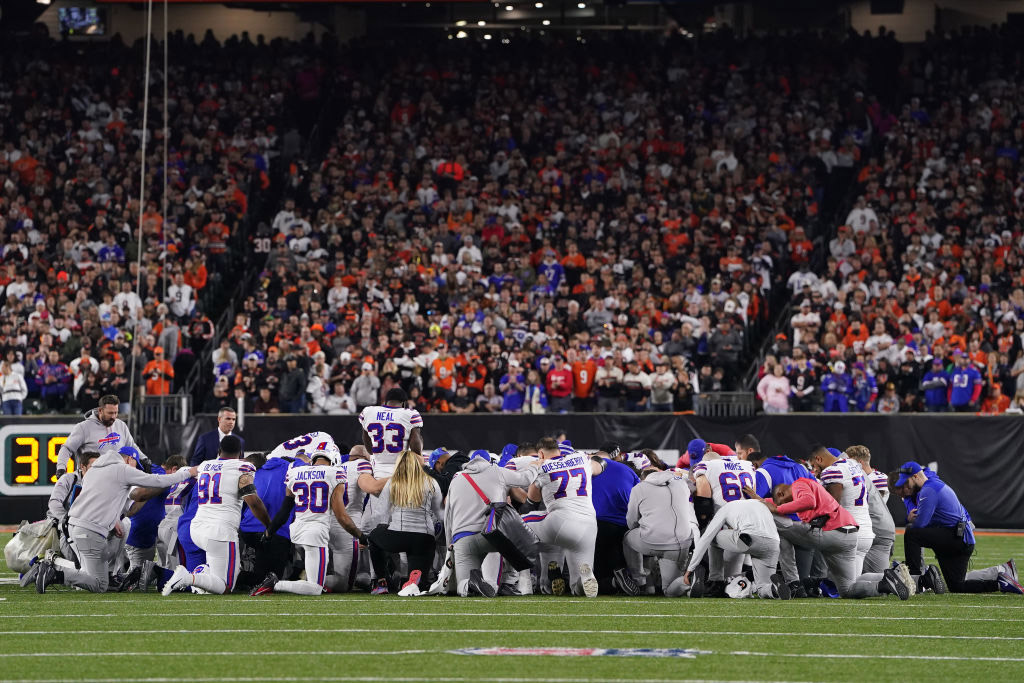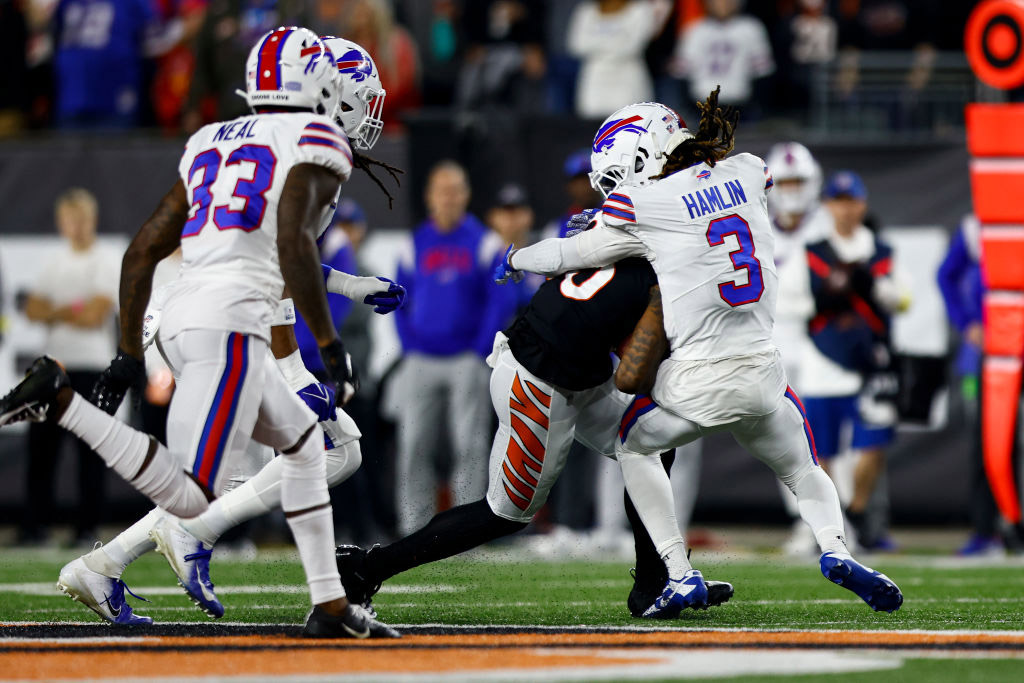- The Story
- The Reach
- The Condition
- The Treatment
- The Damar Hamlin Takeaway
- The Expert RN in a Cardiac Catheterization Lab
- The Expert Pediatric Emergency Nurse in a Level 1 Trauma Department
The Story:
If you watched the Buffalo Bills play the Cincinnati Bengals on January 2, 2023, you are well aware of the Damar Hamlin story. If you weren’t watching, you’ve likely heard, seen, and read about the story in the days since. His collapse was scary and sudden but watching the country band together in support of his recovery while learning and celebrating what a wonderful human being Damar Hamlin is, was beautiful.
Damar Hamlin collapsed because he suffered a Sudden Cardiac Arrest or SCA. It is believed that the cause of his particular SCA was commotio cordis, which is not a phrase, term, or diagnosis that many are familiar with. It’s also not the only cause of SCA, and it may not be essential to know every cause of SCA, as long as you know there is only one way to treat it, regardless of how it happens. Use of a defibrillator or an AED.
The Reach:
Back to the Buffalo Bills and Cincinnati Bengals game on January 2. Most of the country is off in observance of New Year’s Day. Week 17 of the NFL and two playoff-bound teams with seeding placement on the line face off in Cincinnati. The scene at Paycor Stadium, home of the Cincinnati Bengals, was full of energy, competitive and tense. The Bengals had former players, Bengals legends, on hand to meet, greet and sign autographs for the fans. That same energy at Paycor Stadium, at its full capacity of over 65,000 fans, was shared by millions.
23 million. Or, 23,788,000, to be precise, viewing from home, a Monday Night Football record. However, this particular game only had coverage from kickoff until 10:09 in the first quarter, and then the coverage shifted to Scott Van Pelt at the ESPN head offices in Bristol, CT.
That’s because the game lasted just over 8 minutes until Damar Hamlin collapsed during a live broadcast. Eight minutes until teammates, opposing players, staff, concerned fans at the stadium, and concerned fans at home held their collective breath. We held our breath for 9 minutes, which felt like 90 minutes, as we saw the training staff begin CPR. For most, it was the first time witnessing CPR in motion, though nearly all of us have heard of it and know what it is. It was much different to see it live, to see it performed on a 24-year-old, world-class athlete, and to see it make grown men weep.
Think about that. The most-watched game in Monday Night Football history also included arguably the most dramatic and scary scene to be televised live in North American sports history. This event went on for 9 minutes. And the world hasn’t stopped talking about it since.
The Condition:
We wrote about Commotio Cordis last week, which you can read about in more detail in our blog, “What is Commotio Cordis and How Can It Affect Athletes.” What is essential to know is that it’s a condition where a blow or a hit to the chest causes an abnormal heart rhythm that leads to SCA, or Sudden Cardiac Arrest. The clinical name of the rhythm it causes the heart to go into is Ventricular Fibrillation, or VF.
Ventricular Fibrillation is important to simplify. Ventricular refers to that chamber of the heart. In layman’s terms, our hearts are composed of four boxes or chambers. The two on top are atriums, and the two on the bottom are ventricles. The ventricles do a lot of the heavy lifting for our heart, pumping oxygenated blood in and out of our hearts to our brains and other vital organs. When we refer to ventricle, we refer to one of the four chambers of our heart.
Fibrillation is, by definition, an irregular heart rhythm or arrhythmia. In other words, it’s not working normally. We mentioned that the ventricles do a lot of the heavy lifting for our heart, so when one of our ventricles isn’t working properly, the heart can no longer pump blood in and out of the heart to our other vital organs. This specific rhythm, Ventricular Fibrillation, is what almost always leads to Sudden Cardiac Arrest as we know it and what Damar Hamlin likely experienced.
The Treatment:
We’ve established that the ventricle in the heart is acting strangely and that it is acting strangely because it’s in a state of fibrillation. The way to correct this state is to DEfibrillate it. When you think of it this way – the heart is fibrillating, so we need to defibrillate it – you will start to see the importance of having access to a defibrillator or an AED. We witnessed the CPR being performed, but CPR was not the treatment. CPR allowed the treatment to work and bought Damar Hamlin the time needed for the on-field physicians to defibrillate him.
That said, the world will remember the visual of CPR being performed, and we should. Most often, an AED or defibrillator cannot work because CPR was not done prior. When a heart goes into fibrillation, it is most correctable, or ‘shockable,’ the moment the victim goes into arrest. Every 6 seconds, the heart is in ventricular fibrillation without CPR, the victim loses a 1% chance of a shock correcting that rhythm stays in a “shockable” state, meaning a state where the shock from an AED or defibrillator will be able to correct the rhythm back into a normal state.
If a victim of SCA loses a 1% chance of surviving every 6 seconds, that means they lose a 10% chance every 60 seconds. According to most published studies, the average EMS response time is 7 minutes. However, in individual studies, counties, cities, or states indicate even longer times. For instance, the State of New York announced an average 9 minutes and 30 seconds response time in the year 2022.
Performing CPR stops that cycle. By effectively pumping the heart for the victim, the heart stays in that same “shockable” state, and while compressions are performed, the chances of survival don’t reduce; they stay flat.
A 7-minute response time means that you’re 70% less likely to survive SCA without CPR than you are with CPR.
A 9 minutes and 30 seconds response time in New York means that you are 95% less likely to survive SCA if no one performs CPR than if someone does give you CPR.
An AED or defibrillator may be the only way to treat SCA, but an AED or defibrillator usually doesn’t work unless CPR is performed. CPR buys us the time we need until we can get an AED to the scene.
The Damar Hamlin Takeaway:
Damar Hamlin may end up being the perfect champion for SCA. SCA kills over 375,000 people a year in the United States, more than every form of cancer combined. We don’t have a day where every major sporting league wears a particular color to bring attention to it, nor do we have notable celebrities and influencers helping to raise awareness at the same level of some of life’s other unfortunate realities.
Maybe we do now. Damar Hamlin the human being, has reached everyone, as evidenced by the public support of his Go-Fund-Me page and his Chasing M’s Foundation. As scary and sad as his event was and is, and as much as we just want him to get better and get better soon, there is a great opportunity we can take away from this event that we can continue to celebrate as Hamlin makes further strides in his recovery.
Now we know it can happen. Now we know that we need some combination of CPR, AED, and professional help if it does. Knowing is half the battle; most of us would never know without Damar Hamlin.
Thank you, Damar, and our hearts will continue to be with you until you make a full recovery.
The Expert RN in a Cardiac Catheterization Lab:
Sabrina Fine – Cath Lab RN, Mission Hospital
In a situation like we witnessed with Damar Hamlin, there seemed to be some delay to the response efforts. Can you explain what some of those delays may have been?
Sabrina – The first step is to assess the victim or patient. In this instance, the first thought was likely that it was neurological. Additionally, you have extra padding/clothing that needs to be removed. In the ER or cath lab, we just cut away all of the clothing, but in an environment like the NFL, the shoulder pads vary from position to position. That’s true at all levels of athletics. Since tackle gear is different, the ‘perfect’ scenario would be if all players had electrodes on the inside of the pads so you could have them in place, ready to use, and hook up a defibrillator to those pre-existing pads. Currently, we have issues with some of the Redi-Paks electrodes we use in our cath lab sticking due to moisture or sweat on the patient, so the players being very sweaty, along with the additional cost, make this idea prohibitive.
Failing a dream scenario like all players at all levels wearing electrodes at all times, the best recommendation I can give is to get an AED and CPR training. Even then, the cost of an AED may be prohibitive, so the best advice I can give to any parent is to learn CPR and if anything ever happens to their child, call 911 IMMEDIATELY, do not delay; time is so critical. As soon as you have dialed 911 and have a dispatcher on the phone, begin CPR, and don’t stop until a paramedic arrives and takes over.
The other thing parents and coaches should be aware of is that no matter what planning and measures they put into place, they may be unable to prevent this. I didn’t see the impact on Damar and didn’t want to watch the replay, but my co-workers have discussed it at length and don’t feel the impact was out of the ordinary; it was simply the timing of the impact right on the QRS complex. Even if Damar had additional padding, e.g., shoulder pads that covered the entire xiphoid process, his sudden cardiac arrest may have occurred simply due to the timing of the impact.
You mention the impact or the tackle. I know you haven’t watched the game back but do you have any opinion regarding Tee Higgins and the tackle on Damar?
Sabrina – I do. As mentioned before, I work in a department where this was discussed in depth and will continue to be, but nothing ever indicated that the tackle was performed in a manner that led to this. I don’t know the odds, but if you tried to recreate this in a lab, I can’t imagine it would cause SCA even 1% of the time. Probably a lot less than that. It is not because of the force of impact; it is because of the timing of impact, at least as I understand it.
Are there any other takeaways you have from the Damar Hamlin incident?
Sabrina – Awareness and attention to cardiac arrest are big wins, in my estimation. The day after Damar’s cardiac event, we were putting a pacemaker into a patient, and the EP doctor immediately thought that commotio cortis was the cause. It wasn’t, but the fact that we now have an awareness of something that was previously misunderstood or simply not known about is the best first step towards beating this, or any condition, long-term. In my cath lab (Cardiac Catheterization Lab) we had a group of doctors that would have never considered commotio cordis as a cause. Now, they are all eliminating it as a potential cause immediately. The number of cases diagnosed in the country will increase dramatically in 2023, which wouldn’t have happened without Damar Hamlin.
The Expert Pediatric Emergency Nurse in a Level 1 Trauma Department:
Kevin Smith, RN, Flight Medic, Fire Chief, National Ski Patrol OEC Technician
You are a big Buffalo Bills fan and a big advocate for raising awareness for Sudden Cardiac Arrest, CPR, and AED use. What is your take on watching Damar Hamlin suffer a cardiac event live?
Kevin – It’s jarring but I felt I knew what it was the moment it happened. We see it in the trauma center all the time, not just from football but from any contact sport, Field Hockey is a big one up here, and a stick to the chest can have the same effect. It’s the same thing that happened to Korey Stringer; only Korey Stringer didn’t happen on live television with the country watching. The way that Damar collapsed usually only means one thing. I did need to see the tackle back in replay; any time someone collapses after a hit, you want to make sure there isn’t a head, neck, or back injury. But that was a formality; I was sure it was commotio cordis the moment I saw it.
It seems like the shoulder pads would pose a challenge and make performing CPR difficult. That isn’t a specific circumstance covered in a CPR class, so do you have any advice for someone that may be faced with performing CPR on someone wearing shoulder pads?
Kevin – The shoulder pads open right up. You just need to cut the ties or straps in the middle of the chest, and they open to the side, kind of splay open. From there, cut the clothing. We have much better shears in the trauma center than what comes with the typical AED, so if you are part of an athletic department, keep quality shears handy. The same shears used to cut athletic tape and wrap will suffice. It’s really not that uncommon that we have to cut pads away.
Are there any other challenges to be aware of if someone wearing shoulder pads suffers a cardiac event?
Kevin – There really aren’t; time is of the essence, so it’s more important that you get an AED on the way and start compressions than it is to make sure you have everything correct or have taken every possible precaution aside from that of your own personal safety. The person only needs CPR because their heart isn’t pumping, which means they are clinically dead. As long as you’re safe, that person being dead should be your first priority, and the only way to make that person alive again is to start CPR and use an AED as soon as you can.
Last updated January 11, 2023









